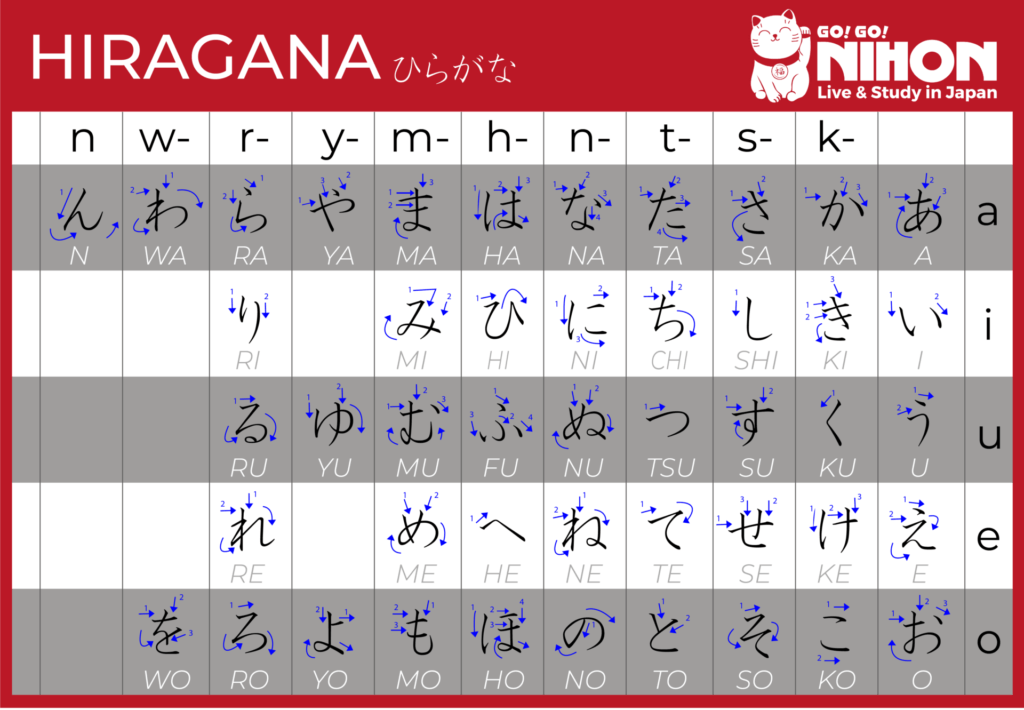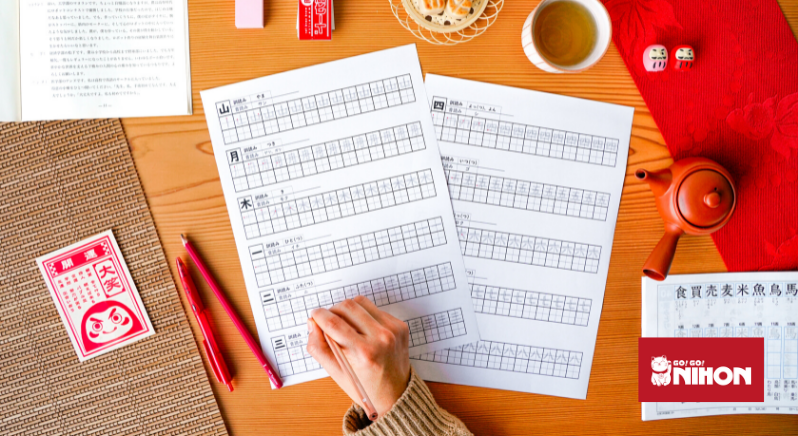
Японская система письма состоит из двух типов иероглифов: слоговых кана – хирагана (яп.仮名) и катакана (яп.片仮名) – и кандзи (яп.漢字). Принятых китайских иероглифов. У каждого из них разные обычаи, цели и характеристики, и все они необходимы в японском письме. Большинство предложений на японском языке содержат комбинации хирагана и кандзи, а иногда и катакана. Хирагана и катакана уникальны для японского языка. И мы настоятельно рекомендуем студентам сначала освоить эти две системы. Прежде чем начинать изучение японского языка в Японии.
Из-за трех разных иероглифов и их различного использования японский письменный язык описывается как один из самых сложных для освоения языков. Читайте дальше, чтобы узнать все о японских иероглифах: хирагана, катакана и кандзи.
Вы можете писать японские иероглифы двумя способами. Во-первых, они могут располагаться столбцами сверху вниз, справа налево (как в китайском языке). Или по горизонтали слева направо, сверху вниз (как на английском). Вот почему некоторые книги открываются корешком вправо, а некоторые — влево.

Хирагана
Хирагана, что буквально означает “обычная” или “простая” кана. Используется в основном для обозначения исконно японских слов и грамматических элементов. Есть 46 основных символов, которые все символизируют слоги, или 71, включая диакритические знаки. Каждый звук в японском языке соответствует одному иероглифу в слоговом словаре. Обычно студенты сначала изучают хирагану, а затем катакану и кандзи.
Хирагана также используется для фуригана (ふりが文) или йомигана (読み仮名), пособие для чтения кандзи. Которое вы найдете рядом с кандзи или над ним. Это поможет вам читать кандзи. Которые вы, возможно, еще не знаете, и это еще одна причина. По которой студентам важно сначала освоить хирагану. Детские книги, предназначенные для маленьких детей. Часто написаны на хирагане.
В более техническом плане хирагана используется для написания:
- Окуригана (送り仮名) или суффиксы, следующие за корнями кандзи. Которые могут образовывать глаголы и прилагательные
- Грамматические и функциональные слова. Такие как частицы
- Японские родные слова без кандзи или с чрезвычайно формальными или сложными формами кандзи.
Эти основные японские иероглифы также можно изменить, добавив маркер дакутэн (濁点) — — ゙) или маркер хандакутэн (半濁点) ( ゚).
Если все это сбивает с толку, не волнуйтесь – вы поймете, как используется хирагана, чем больше вы изучаете японский язык.
Для начала, однако, было бы полезно использовать приложение, подобное нашему собственному приложению Hiragana Quest. Он обучает с помощью мнемотехники. Которая облегчает и увлекает запоминание каждого иероглифа. Узнайте больше здесь!
Katakana
Katakana, meaning “fragmentary kana,” are used primarily for foreign words and names, loanwords and onomatopoeia. Some of the most useful Japanese words are untranslatable onomatopoeia. Such as ギリギリ (girigiri). This means “to be at the limit”, such as just passing, just making it on the train before the doors close. Or being just in time for an appointment.
You can learn more about Japanese onomatopoeia in our article here.
Like hiragana, there are 5 singular vowels, 40 consonant-vowels and 1 singular consonant in katakana. Often you will see both hiragana and katakana in a 5×10 grid, called gojyuon ( 五十音), or “fifty sounds.”
Gairaigo (外来語), or loan words, are all written in katakana, such as バナナ, or banana. Foreign names are similarly also written in katakana. If you have a non-Japanese name. You will probably learn how to write your name in katakana first.

Kanji
There are several thousand kanji characters in regular use. All have different meanings and most have more than one pronunciation. Depending on context. For example, 今日 could be read kyō, meaning “today,” or it could also be read konnichi, meaning “recent days”.
The different readings are categorised as either:
- Onyomi (音読み). Which is “sound reading,” derived from Chinese, or
- Kunyomi (訓読み). Which is “meaning reading,” and are native Japanese readings.
Most characters have at least one of each. But some have more and some only have one.
In Japanese elementary, middle and high schools, students learn more than 2,000 jyoyo kanji (常用漢字). Or regularly-used kanji. Fun fact: that’s also the number of kanji required to pass the highest level of the JLPT. Although there are more than 50,000 kanji. Most native Japanese don’t know nearly as many.
There isn’t really any trick or shortcut to learning kanji. You must learn and memorise each character along with its readings. But what does make it easier is living and studying in Japan, where you are exposed to Japanese every day. You will get accustomed to how words are read and used faster than you would learning Japanese in your home country.
Learn more about the benefits of learning Japanese through full immersion here.
Rōmaji
In Japan you will also see the Roman alphabet used to spell out sounds. Rōmaji (ローマ字), or the romanised letters, may be used where Japanese text is targeted at non-Japanese speakers. Such as on street signs. Dictionaries. Textbooks and passports.
Rōmaji is also used when typing on the computer. Although Japanese keyboards have the capacity to type with kana. Many people use the latin script to type out the sounds and characters in rōmaji.
When you’re first learning the characters. Rōmaji will help you read the Japanese words.
Get the basics right with Go! Go! Nihon
All of this can sound a bit overwhelming. Especially for beginners. No worries, there are plenty of great resources out there to put you on the right track, from phone applications to books. And even games!
We’ve got some great articles if you’re learning Japanese at home:
*Go! Go! Nihon’s free Japanese language resources
*The best apps to learn Japanese
*In self-isolation? Use this time to learn some Japanese at home!
Free hiragana & katakana resources
Further your hiragana and katakana study with our free online guides. You can access them in all the languages that we support here.
Get organised with our study planner and test your katakana skills with our quiz. If you like. You can also make your own paper Daruma doll!
Another great way to master the basics is to take our online beginner Japanese course. We partnered with Akamonkai Japanese Language School to offer a comprehensive 12-week course designed to give you the best foundation to develop your language skills from. Learn more about the course here.
If you’re totally new to Japanese and you’re planning on visiting Japan in the future. Our online beginner crash course would be the perfect learning opportunity. In just 2 weeks you’ll learn useful essential Japanese phrases needed to navigate daily life in Japan. As well as discover Japanese cultural activities and take virtual tours. Learn more here.
For more information or if you have any questions. Feel free to contact us!





